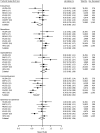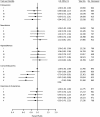Personality and all-cause mortality: individual-participant meta-analysis of 3,947 deaths in 76,150 adults - PubMed (original) (raw)
Meta-Analysis
. 2013 Sep 1;178(5):667-75.
doi: 10.1093/aje/kwt170. Epub 2013 Aug 1.
Affiliations
- PMID: 23911610
- PMCID: PMC3755650
- DOI: 10.1093/aje/kwt170
Meta-Analysis
Personality and all-cause mortality: individual-participant meta-analysis of 3,947 deaths in 76,150 adults
Markus Jokela et al. Am J Epidemiol. 2013.
Abstract
Personality may influence the risk of death, but the evidence remains inconsistent. We examined associations between personality traits of the five-factor model (extraversion, neuroticism, agreeableness, conscientiousness, and openness to experience) and the risk of death from all causes through individual-participant meta-analysis of 76,150 participants from 7 cohorts (the British Household Panel Survey, 2006-2009; the German Socio-Economic Panel Study, 2005-2010; the Household, Income and Labour Dynamics in Australia Survey, 2006-2010; the US Health and Retirement Study, 2006-2010; the Midlife in the United States Study, 1995-2004; and the Wisconsin Longitudinal Study's graduate and sibling samples, 1993-2009). During 444,770 person-years at risk, 3,947 participants (54.4% women) died (mean age at baseline = 50.9 years; mean follow-up = 5.9 years). Only low conscientiousness-reflecting low persistence, poor self-control, and lack of long-term planning-was associated with elevated mortality risk when taking into account age, sex, ethnicity/nationality, and all 5 personality traits. Individuals in the lowest tertile of conscientiousness had a 1.4 times higher risk of death (hazard ratio = 1.37, 95% confidence interval: 1.18, 1.58) compared with individuals in the top 2 tertiles. This association remained after further adjustment for health behaviors, marital status, and education. In conclusion, of the higher-order personality traits measured by the five-factor model, only conscientiousness appears to be related to mortality risk across populations.
Keywords: meta-analysis; mortality; personality; psychology; survival analysis.
Figures
Figure 1.
Hazard ratios associated with a 1–standard deviation increment in personality trait score for mutually adjusted personality traits, additionally adjusted for sex, age, and ethnicity/nationality. The overall estimates are based on random-effects meta-analysis. Squares represent study-specific estimates, and diamonds represent pooled estimates of random-effects meta-analyses. Bars, 95% confidence interval (CI). BHPS, British Household Panel Survey (United Kingdom, 2006–2009); GSOEP, German Socio-Economic Panel Study (Germany, 2005–2010); HILDA, Household, Income and Labour Dynamics in Australia Survey (Australia, 2006–2010); HRS, Health and Retirement Study (United States, 2006–2010); MIDUS, Midlife in the United States Study (United States, 1995–2004); WLSG, Wisconsin Longitudinal Study's graduate sample (United States, 1993–2009); WLSS, Wisconsin Longitudinal Study's sibling sample (United States, 1994–2009).
Figure 2.
Associations between personality score quintiles and mortality risk based on random-effects meta-analysis of the 7 cohorts (representing 76,150 individuals and 3,947 deaths). For each trait, the lowest quintile is the reference category. Personality traits are mutually adjusted, and the model is further adjusted for sex, age, and ethnicity/nationality. Squares represent pooled estimates of random-effects meta-analyses for personality trait quintiles. Bars, 95% confidence interval (CI). Data were pooled from the British Household Panel Survey (United Kingdom, 2006–2009); the German Socio-Economic Panel Study (Germany, 2005–2010); Household, Income, and Labour Dynamics in Australia (Australia, 2006–2010); the Health and Retirement Study (United States, 2006–2010); Midlife in the United States (United States, 1995–2004); the Wisconsin Longitudinal Study's graduate sample (United States, 1993–2009); and the Wisconsin Longitudinal Study's sibling sample (United States, 1994–2009).
Comment in
- Invited commentary: Personality phenotype and mortality--new avenues in genetic, social, and clinical epidemiology.
Chapman BP. Chapman BP. Am J Epidemiol. 2013 Sep 1;178(5):676-8. doi: 10.1093/aje/kwt169. Epub 2013 Aug 1. Am J Epidemiol. 2013. PMID: 23911611 Free PMC article. - Re: "Personality and all-cause mortality: individual-participant meta-analysis of 3,947 deaths in 76,150 adults".
Weiss A, Costa PT Jr. Weiss A, et al. Am J Epidemiol. 2014 Mar 15;179(6):791-2. doi: 10.1093/aje/kwt300. Epub 2014 Feb 5. Am J Epidemiol. 2014. PMID: 24503946 No abstract available. - Dr. Chapman replies.
Chapman BP. Chapman BP. Am J Epidemiol. 2014 Mar 15;179(6):793-4. doi: 10.1093/aje/kwt301. Epub 2014 Feb 5. Am J Epidemiol. 2014. PMID: 24503947 No abstract available. - The authors reply.
Jokela M, Batty GD, Nyberg ST, Virtanen M, Nabi H, Singh-Manoux A, Kivimäki M. Jokela M, et al. Am J Epidemiol. 2014 Mar 15;179(6):792-3. doi: 10.1093/aje/kwu009. Am J Epidemiol. 2014. PMID: 24738124 Free PMC article. No abstract available.
Similar articles
- Is personality associated with cancer incidence and mortality? An individual-participant meta-analysis of 2156 incident cancer cases among 42,843 men and women.
Jokela M, Batty GD, Hintsa T, Elovainio M, Hakulinen C, Kivimäki M. Jokela M, et al. Br J Cancer. 2014 Apr 2;110(7):1820-4. doi: 10.1038/bjc.2014.58. Epub 2014 Feb 6. Br J Cancer. 2014. PMID: 24504367 Free PMC article. - Five-factor model personality traits and grip strength: Meta-analysis of seven studies.
Stephan Y, Sutin AR, Canada B, Deshayes M, Kekäläinen T, Terracciano A. Stephan Y, et al. J Psychosom Res. 2022 Sep;160:110961. doi: 10.1016/j.jpsychores.2022.110961. Epub 2022 Jun 11. J Psychosom Res. 2022. PMID: 35779438 Free PMC article. - Personality and smoking: individual-participant meta-analysis of nine cohort studies.
Hakulinen C, Hintsanen M, Munafò MR, Virtanen M, Kivimäki M, Batty GD, Jokela M. Hakulinen C, et al. Addiction. 2015 Nov;110(11):1844-52. doi: 10.1111/add.13079. Epub 2015 Aug 22. Addiction. 2015. PMID: 26227786 Free PMC article. - Association of personality with the development and persistence of obesity: a meta-analysis based on individual-participant data.
Jokela M, Hintsanen M, Hakulinen C, Batty GD, Nabi H, Singh-Manoux A, Kivimäki M. Jokela M, et al. Obes Rev. 2013 Apr;14(4):315-23. doi: 10.1111/obr.12007. Epub 2012 Nov 26. Obes Rev. 2013. PMID: 23176713 Free PMC article. Review. - Is personality associated with dementia risk? A meta-analytic investigation.
Aschwanden D, Strickhouser JE, Luchetti M, Stephan Y, Sutin AR, Terracciano A. Aschwanden D, et al. Ageing Res Rev. 2021 May;67:101269. doi: 10.1016/j.arr.2021.101269. Epub 2021 Feb 6. Ageing Res Rev. 2021. PMID: 33561581 Free PMC article. Review.
Cited by
- Causal effects between personality and psychiatric traits and lung cancer: a bidirectional two-sample Mendelian randomization and bibliometric study.
Chen S, Du Z, Qin Y, Li Y, Pan Y, Qiao Y, Chen J, Hou Z, Jin S, Tao H, Yu H, Qin J, Zhu M, Wang Z, Liu Z. Chen S, et al. Front Psychiatry. 2024 Sep 12;15:1338481. doi: 10.3389/fpsyt.2024.1338481. eCollection 2024. Front Psychiatry. 2024. PMID: 39328349 Free PMC article. - Decomposing the association of psychosocial wellbeing with all-cause mortality: the mediating role of physical health and lifestyle factors.
Alimujiang A, Strecher V, McLean K, Mondul AM, Pearce CL, Mukherjee B. Alimujiang A, et al. Soc Psychiatry Psychiatr Epidemiol. 2024 Jul 23. doi: 10.1007/s00127-024-02717-y. Online ahead of print. Soc Psychiatry Psychiatr Epidemiol. 2024. PMID: 39044017 - Time perspective profile and self-reported health on the EQ-5D.
Rencz F, Janssen MF. Rencz F, et al. Qual Life Res. 2024 Jan;33(1):73-85. doi: 10.1007/s11136-023-03509-8. Epub 2023 Sep 8. Qual Life Res. 2024. PMID: 37682495 Free PMC article. - Association Between Big Five Personality Traits and Hypertension in Saudi Patients: A Case Control Study.
Lone A, Othman Albotuaiba A. Lone A, et al. Psychol Res Behav Manag. 2023 Aug 28;16:3427-3435. doi: 10.2147/PRBM.S416828. eCollection 2023. Psychol Res Behav Manag. 2023. PMID: 37664136 Free PMC article. - Role of personal aptitudes as determinants of incident morbidity, lifestyles, quality of life, use of health services, and mortality (DESVELA cohort): quantitative study protocol for a prospective cohort study in a hybrid analysis.
Martí-Lluch R, Bolíbar B, Llobera J, Maderuelo-Fernández JA, Magallón-Botaya R, Sánchez-Pérez Á, Fernández-Domínguez MJ, Motrico E, Vicens-Pons E, Notario-Pacheco B, Alves-Cabratosa L, Ramos R; DESVELA Cohort Investigators. Martí-Lluch R, et al. Front Public Health. 2023 Jun 22;11:1067249. doi: 10.3389/fpubh.2023.1067249. eCollection 2023. Front Public Health. 2023. PMID: 37427254 Free PMC article.
References
- Smith TW, MacKenzie J. Personality and risk of physical illness. Annu Rev Clin Psychol. 2006;2:435–467. - PubMed
- Bogg T, Roberts BW. Conscientiousness and health-related behaviors: a meta-analysis of the leading behavioral contributors to mortality. Psychol Bull. 2004;130(6):887–919. - PubMed
- Kotov R, Gamez W, Schmidt F, et al. Linking “Big” personality traits to anxiety, depressive, and substance use disorders: a meta-analysis. Psychol Bull. 2010;136(5):768–821. - PubMed
- Friedman HS, Tucker JS, Schwartz JE, et al. Psychosocial and behavioral predictors of longevity: the aging and death of the ‘Termites. Am Psychol. 1995;50(2):69–78. - PubMed
Publication types
MeSH terms
Grants and funding
- K013351/MRC_/Medical Research Council/United Kingdom
- R01 HL036310/HL/NHLBI NIH HHS/United States
- R01 AG034454/AG/NIA NIH HHS/United States
- RG/13/2/30098/BHF_/British Heart Foundation/United Kingdom
- P01 AG020166/AG/NIA NIH HHS/United States
- MR/K026992/1/MRC_/Medical Research Council/United Kingdom
- R01AG034454/AG/NIA NIH HHS/United States
- R01HL036310/HL/NHLBI NIH HHS/United States
LinkOut - more resources
Full Text Sources
Other Literature Sources

